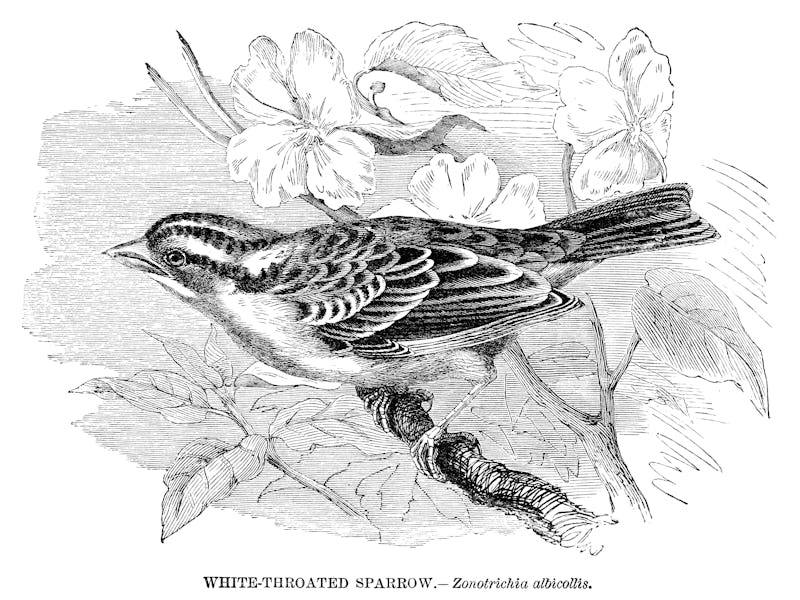Driven by female taste, bird song remix spreads across North America
"There's a big advantage to any male who can sing a new song type."

Song remixes can be polarizing — but sometimes there's no debating that a solid remix is better than the original.
This especially applies to a particular bird call that rapidly — and prior to new research, mysteriously — upended sparrow song in North America.
Over the past 20 years, a new version of the white-throated sparrow's song has spread thousands of miles across North America. This kind of change is unprecedented, reports a study published Thursday in the journal Current Biology. Bird songs are typically slow to change, especially within a local area.
Like much of North American pop music, the new song was released out west and spread eastward. Researchers think that juvenile birds from the west may have taught others the new tune while spending the winter together in the southern United States.
Now, it seems to have overtaken what was once the most popular sparrow song.
Evolution of a song — For many decades, white-throated sparrows sung the same song.
The traditional call involves two longer notes followed by three short notes. Birders have described the rhythm as sounding something like Oh-sweet-Canada-Canada. The Canada part is called a triplet.
However, sometime between the 1960s and the year 2000, sparrows in Canada living west of the Rocky Mountains began singing a new tune. Instead of a triplet, this song ends in a doublet, with just two notes.
You can hear the difference between the two calls in this video:
Video showing the two different sparrow songs.
The song dialect that features the doublet is apparently a real hit among birds.
Before 2000, hearing the doublet version was rare. But instances of the song spread across Canada over the past two decades, the study reports. With the help of citizen scientists recording bird songs, researchers tracked how the song moved from British Columbia to Alberta to Ontario, Canada.
Animation shows the song spreading across North America.
It's an "unprecedented rate of song transition," lead author Ken Otter, a biology professor at the University of Northern British Columbia, explains in the study's video abstract.
To better understand how the bird song spread, researchers fitted sparrows with "tiny backpacks" holding geolocators.
The geolocators tracked levels of ambient light, which researchers used to track where the birds flew during migration. The data shows that younger birds may have been singing and sharing the song remix while hanging out during the winter months.
Geolocator sticking out through the white-throated sparrow's feathers.
The sparrows that breed west of the Rocky Mountains spend the winter in areas like Coastal California, eastern Texas, Oklahoma, Arkansas, and Kansas. These were the birds who were singing the doublet song before it was cool
Birds from the east spend time in some of those areas, too.
"We know that birds sing on the wintering grounds, so juvenile males may be able to pick up new song types if they overwinter with birds from other dialect areas," Otter said. "This would allow males to learn new song types in the winter and take them to new locations when they return to breeding grounds, helping explain how the song type could spread."
Female taste drives song change — The reason the remix has become more popular than original may be because of how females are responding to males singing the song, Otter and his colleagues hypothesize.
Usually, females prefer whatever the local song type is. But some research has suggested that, over time, females may be less responsive to hearing the same old song.
This may be the case for white-throated sparrows. Researchers "might find a situation in which the females actually like songs that aren't typical in their environment," Otter says.
"If that's the case, there's a big advantage to any male who can sing a new song type."
Abstract: Hypotheses on regional song variation (‘‘dialects’’) assume that dialects remain stable within regions, are distinct between regions, and persist within populations over extensive periods [1–3]. Theories to explain dialects focus on mechanisms that promote persistence of regional song variants despite gene flow between regions [4–6], such as juveniles settling in non-natal populations retaining only those songs from their repertoires that match neighbors [7, 8]. It would be considered atypical for a novel song variant to invade and replace the established regional variant. Yet some studies have reported song variants shifting rapidly over time within populations [9–11]. White-throated sparrows, Zonotrichia albicolis, for example, traditionally sing a whistled song terminating in a repeated triplet of notes [12], which was the ubiquitous variant in surveys across Canada in the 1960s [13]. However, doublet-ending songs emerged and replaced triplet-ending songs west of the Rocky Mountains sometime between 1960 and 2000 [11] and appeared just east of the Rockies in the 2000s [14]. From recordings collected over two decades across North America, we show that doubletending song has now spread at a continental scale. Using geolocator tracking, we confirm that birds from western Canada, where doublet-ending songs originated, overwinter with birds from central Canada, where the song initially spread. This suggests a potential mechanism for spread through song tutoring on wintering grounds. Where the new song variant has spread, it rose from a rare variant to the sole, regional song type, as predicted by the indirect biased transmission hypothesis [10].